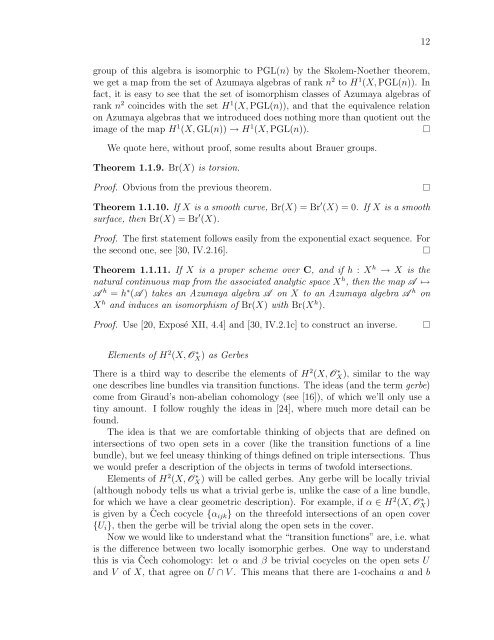derived categories of twisted sheaves on calabi-yau manifolds
derived categories of twisted sheaves on calabi-yau manifolds
derived categories of twisted sheaves on calabi-yau manifolds
You also want an ePaper? Increase the reach of your titles
YUMPU automatically turns print PDFs into web optimized ePapers that Google loves.
group <str<strong>on</strong>g>of</str<strong>on</strong>g> this algebra is isomorphic to PGL(n) by the Skolem-Noether theorem,<br />
we get a map from the set <str<strong>on</strong>g>of</str<strong>on</strong>g> Azumaya algebras <str<strong>on</strong>g>of</str<strong>on</strong>g> rank n 2 to H 1 (X, PGL(n)). In<br />
fact, it is easy to see that the set <str<strong>on</strong>g>of</str<strong>on</strong>g> isomorphism classes <str<strong>on</strong>g>of</str<strong>on</strong>g> Azumaya algebras <str<strong>on</strong>g>of</str<strong>on</strong>g><br />
rank n 2 coincides with the set H 1 (X, PGL(n)), and that the equivalence relati<strong>on</strong><br />
<strong>on</strong> Azumaya algebras that we introduced does nothing more than quotient out the<br />
image <str<strong>on</strong>g>of</str<strong>on</strong>g> the map H 1 (X, GL(n)) → H 1 (X, PGL(n)).<br />
We quote here, without pro<str<strong>on</strong>g>of</str<strong>on</strong>g>, some results about Brauer groups.<br />
Theorem 1.1.9. Br(X) is torsi<strong>on</strong>.<br />
Pro<str<strong>on</strong>g>of</str<strong>on</strong>g>. Obvious from the previous theorem.<br />
Theorem 1.1.10. If X is a smooth curve, Br(X) = Br ′ (X) = 0. If X is a smooth<br />
surface, then Br(X) = Br ′ (X).<br />
Pro<str<strong>on</strong>g>of</str<strong>on</strong>g>. The first statement follows easily from the exp<strong>on</strong>ential exact sequence. For<br />
the sec<strong>on</strong>d <strong>on</strong>e, see [30, IV.2.16].<br />
Theorem 1.1.11. If X is a proper scheme over C, and if h : X h → X is the<br />
natural c<strong>on</strong>tinuous map from the associated analytic space X h , then the map A ↦→<br />
A h = h ∗ (A ) takes an Azumaya algebra A <strong>on</strong> X to an Azumaya algebra A h <strong>on</strong><br />
X h and induces an isomorphism <str<strong>on</strong>g>of</str<strong>on</strong>g> Br(X) with Br(X h ).<br />
Pro<str<strong>on</strong>g>of</str<strong>on</strong>g>. Use [20, Exposé XII, 4.4] and [30, IV.2.1c] to c<strong>on</strong>struct an inverse.<br />
Elements <str<strong>on</strong>g>of</str<strong>on</strong>g> H2 (X, O∗ X ) as Gerbes<br />
There is a third way to describe the elements <str<strong>on</strong>g>of</str<strong>on</strong>g> H2 (X, O∗ X ), similar to the way<br />
<strong>on</strong>e describes line bundles via transiti<strong>on</strong> functi<strong>on</strong>s. The ideas (and the term gerbe)<br />
come from Giraud’s n<strong>on</strong>-abelian cohomology (see [16]), <str<strong>on</strong>g>of</str<strong>on</strong>g> which we’ll <strong>on</strong>ly use a<br />
tiny amount. I follow roughly the ideas in [24], where much more detail can be<br />
found.<br />
The idea is that we are comfortable thinking <str<strong>on</strong>g>of</str<strong>on</strong>g> objects that are defined <strong>on</strong><br />
intersecti<strong>on</strong>s <str<strong>on</strong>g>of</str<strong>on</strong>g> two open sets in a cover (like the transiti<strong>on</strong> functi<strong>on</strong>s <str<strong>on</strong>g>of</str<strong>on</strong>g> a line<br />
bundle), but we feel uneasy thinking <str<strong>on</strong>g>of</str<strong>on</strong>g> things defined <strong>on</strong> triple intersecti<strong>on</strong>s. Thus<br />
we would prefer a descripti<strong>on</strong> <str<strong>on</strong>g>of</str<strong>on</strong>g> the objects in terms <str<strong>on</strong>g>of</str<strong>on</strong>g> tw<str<strong>on</strong>g>of</str<strong>on</strong>g>old intersecti<strong>on</strong>s.<br />
) will be called gerbes. Any gerbe will be locally trivial<br />
Elements <str<strong>on</strong>g>of</str<strong>on</strong>g> H2 (X, O∗ X<br />
(although nobody tells us what a trivial gerbe is, unlike the case <str<strong>on</strong>g>of</str<strong>on</strong>g> a line bundle,<br />
for which we have a clear geometric descripti<strong>on</strong>). For example, if α ∈ H2 (X, O∗ X )<br />
is given by a Čech cocycle {αijk} <strong>on</strong> the threefold intersecti<strong>on</strong>s <str<strong>on</strong>g>of</str<strong>on</strong>g> an open cover<br />
{Ui}, then the gerbe will be trivial al<strong>on</strong>g the open sets in the cover.<br />
Now we would like to understand what the “transiti<strong>on</strong> functi<strong>on</strong>s” are, i.e. what<br />
is the difference between two locally isomorphic gerbes. One way to understand<br />
this is via Čech cohomology: let α and β be trivial cocycles <strong>on</strong> the open sets U<br />
and V <str<strong>on</strong>g>of</str<strong>on</strong>g> X, that agree <strong>on</strong> U ∩ V . This means that there are 1-cochains a and b<br />
12
















